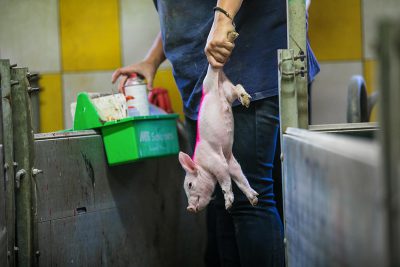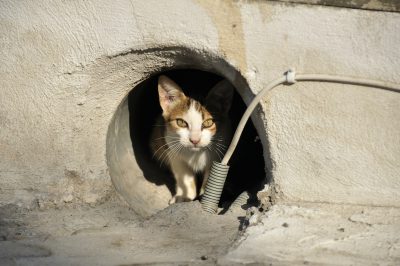The farming and eating of animals has profound consequences for our planet, all wildlife, and our own health, as well as causing suffering to farmed animals on an unimaginable scale. Here, we examine the realities of life on farms, explore what this industry means for both our planetary and personal health, and look at the best way to use our food choices for the good of all.
What Is Animal Agriculture?
This is the term given to the industry that incarcerates, breeds, fattens, exploits, and slaughters animals for their meat, milk, eggs and skins. It is an incredibly wealthy industry, but its profits are founded on the suffering of billions of animals.
What Is Animal Agriculture Called?
People may refer to this industry by other names, such as:
- Animal farming
- “Livestock” farming
- Animal husbandry
- Intensive farming
- Factory farming, or
- Ranching
There are some differences between these, as different species of animals may be raised in different ways, and there are also different types of farming for the same species.
What Are the Different Types of Animal Agriculture?
Most of the 80 billion animals bred and killed globally each year are raised intensively. That is, they are penned or caged along with vast numbers of other animals and are denied the things that make their life worthwhile, such as fresh air, the earth beneath their feet, and freedom to roam, swim, or fly. Animals’ needs are met only insofar as they help boost profits. Nothing else matters.

Factory Farmed Chickens
Chicken is the most consumed meat on the planet, and that means astronomical numbers of birds are bred and killed. They are kept inside immense warehouses, with each shed holding tens of thousands of birds. Nothing about the process is natural, not even the birds’ bodies, which have been deliberately bred to grow so fast that broken bones and heart failure are commonplace. Millions of birds don’t even survive their allotted six weeks of life. Those who do survive are trucked long distances and slaughtered on arrival. They will never have scratched in the earth, dustbathed, or spread out their wings to enjoy the sun, as chickens would naturally choose to do. And that is before we get to the horrors of the egg industry, where these incredibly inquisitive and fun-loving animals spend their entire lives in a cage.
Factory Farmed Cows
These gentle animals are bred, reared, and slaughtered on an industrial scale, so people can take and eat their meat and their milk. Those who are reared by the beef industry may begin their lives on the range, foraging and fending for themselves, but most are trucked to feedlot factory farms within their first year. There, these young animals may be branded, de-horned, and castrated, all without pain relief. On the feedlot, these natural roamers and grazers have nothing to do and nowhere to go. They stand in a crowded pen all day every day until they are loaded onto a truck and sent to be slaughtered, as if their lives did not matter at all.
Cows who are farmed by the dairy industry do not just give milk because it is required of them. Like all mammals, cows produce milk to feed their young. And so the dairy industry cynically exploits this reproductive ability, forcibly impregnating them, taking away their calf, and then taking the milk as well. It is an utterly ruthless system.
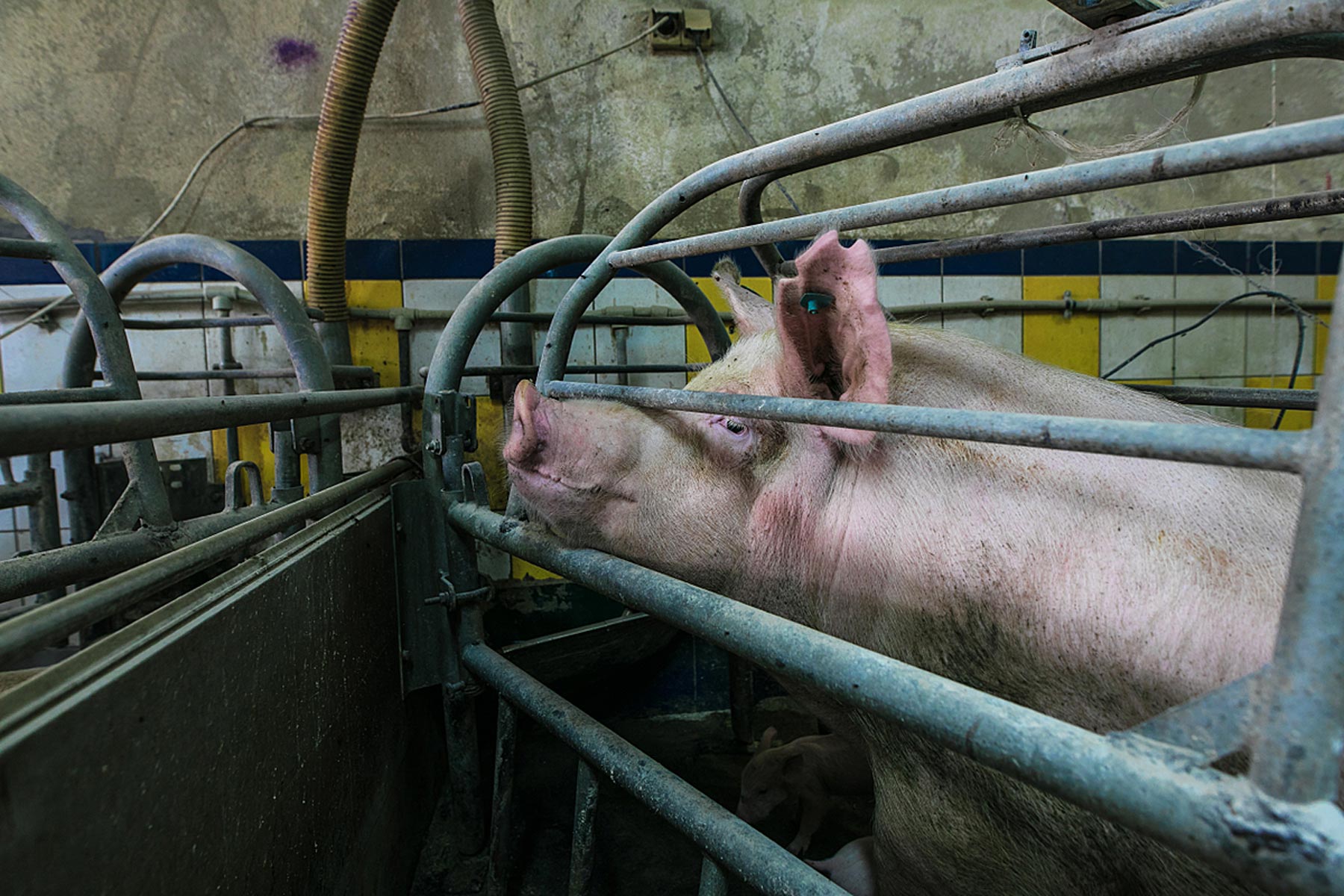
Factory Farmed Pigs
The suffering inflicted on pigs—who share many characteristics with dogs, including intelligence, sociability, tail-wagging when happy, and a deep love of belly rubs—is so bad that a person would be jailed if they treated a dog the way pigs are routinely treated on farms. In the US, almost all pigs are factory farmed. They are forcibly impregnated, locked in tiny cages, have their tails cut off, and their teeth ground down. They are forced to give birth on barren concrete floors which cause serious pressure wounds on their bodies, or on a slatted floor that marks their skin. When their piglets are born, the mothers are not permitted to reach them, in order to nuzzle and comfort them. Their babies are taken from them and fattened for those who like to eat them. Their mothers endure the repeated cycle of pregnancies and loss, until they are exhausted and broken—when they too are sent to the slaughterhouse.
Factory Farmed Fish
Around half of all aquatic animals eaten today were reared in farms. All fish farming is intensive, and creates a host of serious welfare and environmental problems. Fish should be swimming in wide open rivers and oceans, but trapped in those filthy crowded farm pools, they get stressed and sick. Disease is rife. Drugs are routinely added into the water to try to keep as many animals alive as possible, but still vast numbers die. These medications—as well as the lice they are infested with and dangerous pathogens—get out into wild waters where they impact the local aquatic populations, their ecosystem, and the whole environment.
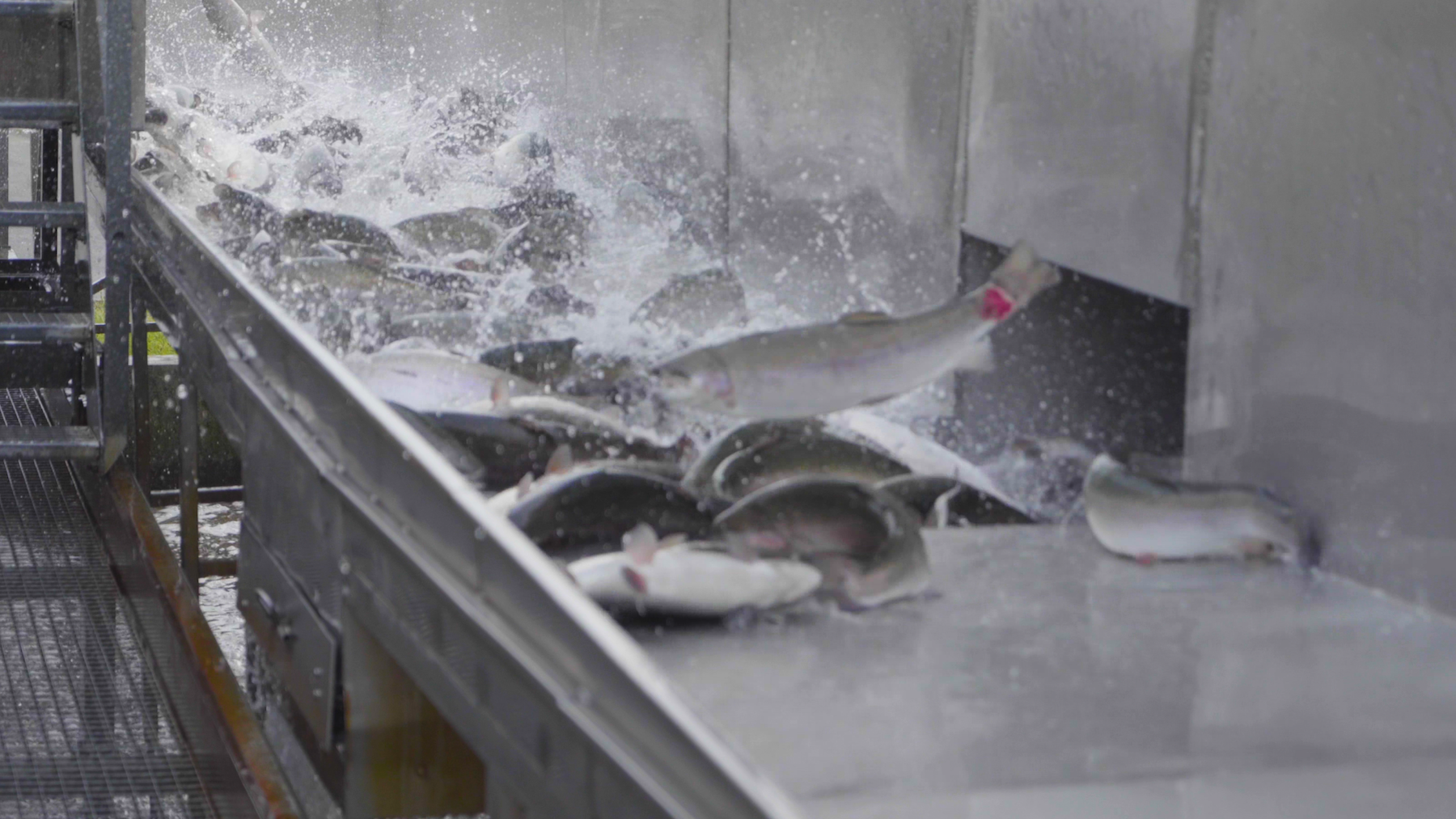
What Percent of Animals Come From Factory Farms?
In the United States, almost every animal is factory farmed, including
- 99.9 percent of chickens
- 98 percent of pigs
- 70 percent of cows
- 99.8 percent of turkeys
- And globally, half of all fish consumed were also intensively farmed
What Is the Problem With Animal Agriculture?
There are so many problems that it is almost impossible to know where to begin, but let’s start with the mass incarceration, exploitation, and slaughter of billions of animals every year. Inflicting such suffering on our fellow animals is incomprehensible, but also, we believe, indefensible.

Why Is Animal Agriculture Bad?
Animal farming is obviously bad for animals. They are bred only to suffer and be killed, and are “cared for” just enough to keep them alive until the industry is ready to slaughter them. If we think about this dispassionately for even a moment, the cruelty and injustice is plain to see.
Intense Confinement
Most animals are kept in intense confinement—they are caged, penned, or crowded into sheds or feedlots, alongside thousands of other animals. The air is toxic. The floor beneath them is covered in feces. There is no comfort, no enrichment, and no dignity at all. Just a life of stress, distress, and suffering.
Antibiotics
Under such circumstances, animals inevitably get sick, and because they are kept in such crowded confinement, disease can spread rapidly. Now, the lives of those individual animals may not matter to the industry that exploits them, but its profits depend on as many animals as possible surviving the ordeal. For that reason, animals are routinely fed huge amounts of antibiotics. This only allows farmers to continue raising animals in appalling conditions, but it has serious repercussions for all of humanity. When we overuse antibiotics, we allow drug-resistant pathogens to emerge. And that is happening already. These superbugs make around 2.8 million Americans sick each year, and cause up to 35,000 deaths. This toll will only worsen if we continue to use antibiotics to prop up the factory farming system.
Animal Abuse
There are many legal mutilations forced onto animals trapped in the farming system—from branding and dehorning to castrations. But undercover investigations from all over the world, repeatedly find deliberate and vicious animal abuse, too. Farmers, farm workers, and slaughterers have been filmed kicking, beating, slapping, electrocuting, whipping, and deliberately burning animals. It’s hard to imagine how anyone could behave this way, but this is a system that breeds desensitization, and such violence is so commonplace that it appears to be an inevitability of farming and slaughtering animals.
Taking Their Lives
Life is often difficult but it is also precious, and chickens, cows, pigs, and all other animals value their own lives as much as we value ours. Those individuals born into the pitiless farming system have no autonomy over theirs. Although each individual has a distinct personality with their own character traits, preferences, and wishes, none get to choose anything about their lives. They are kept confined, fed on processed foods, forced to breed, legally mutilated, have all their instincts thwarted, their young stolen, all pleasures denied them, and then the only thing they have left—their life—is also taken away.
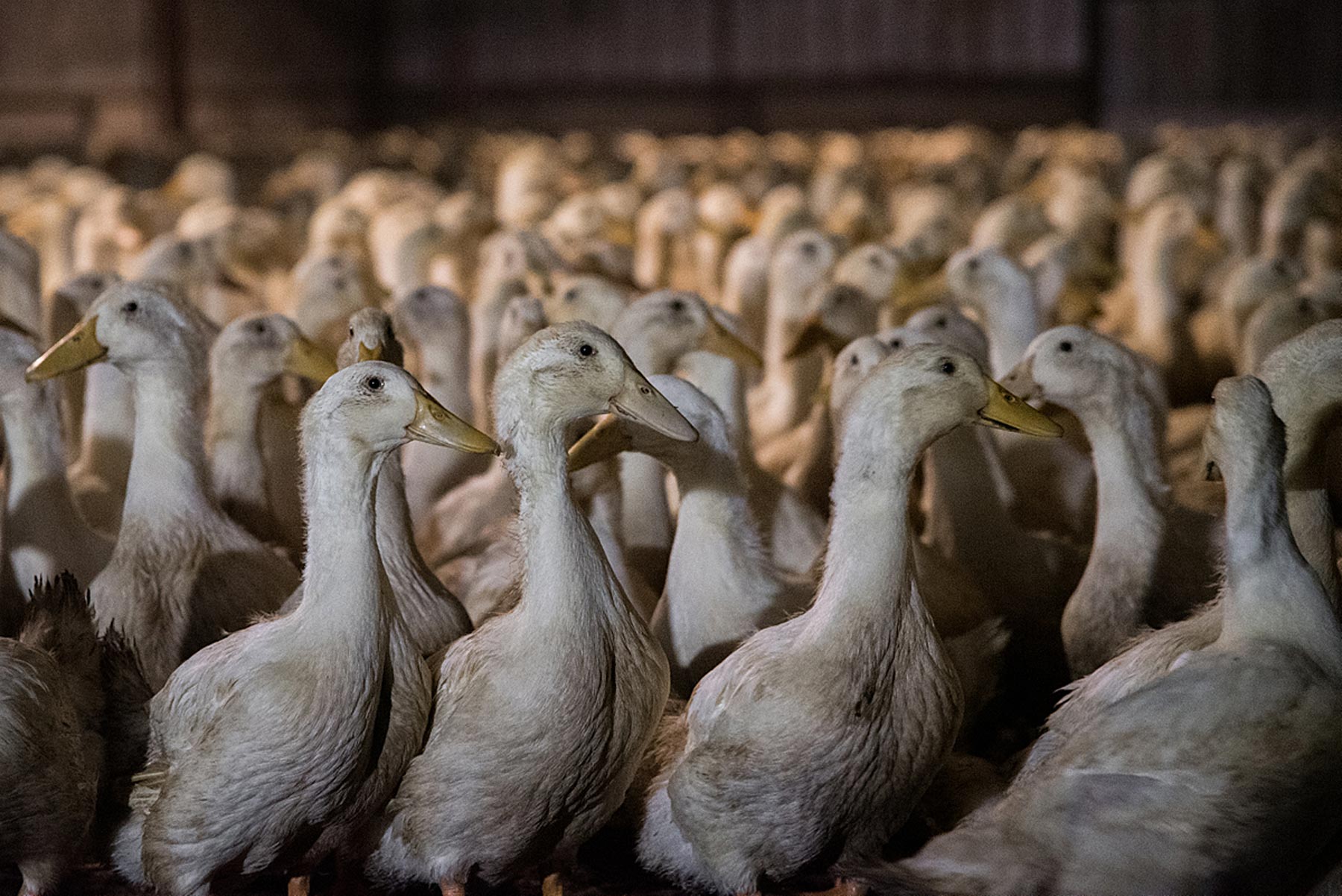
How Does Animal Agriculture Affect Global Warming?
As if the suffering of animals, and the deaths of people due to antibiotic resistance, wasn’t bad enough, animal agriculture is one of the leading drivers of climate breakdown.
Animal Agriculture Greenhouse Gas Emissions
The farming of animals is a major emitter of greenhouse gasses. At least 14.5 percent of all climate-damaging emissions come from this sector, which is more than the exhaust from every car, bus, truck, ship, plane, and train on the planet. Plant foods have a fraction of the impact which means the best thing we can do as individuals to address our own carbon footprint is to change the way we eat.
Animal Agriculture Waste and Water Pollution
By breeding so many farmed animals, the industry has created a major waste issue. All those billions of animals must poop, and the huge amounts of manure must go somewhere and it ends up in rivers, lakes, and oceans, where it creates deadly algal blooms. These blooms deprive the water of oxygen, thereby killing aquatic life. When we eat meat, eggs, and milk, we are inadvertently contributing to this environmental destruction. Eating farmed animals has a devastating impact on wild animals and wild places, too.
How Much Land Is Used for Animal Agriculture?
Half of the world’s habitable land is used for agriculture. This extensive land use has a major impact on the Earth’s environment as it reduces wilderness and threatens biodiversity. For this reason, it is good to know exactly which foods demand the most land, and which provide us with all we need, while also ensuring there is enough left for wild populations to flourish. These are important figures for everyone who wishes to reduce their own impact on the planet:
77 percent of global farmland is used to produce meat, eggs, and dairy, but it gives us just 18 percent of our calories.
Just 23 percent of the land is used for plant-based foods, but it provides us with 82 percent of our calories.
Almost every product that is made from, or taken from, animals requires a lot more land than almost every fruit, grain, nut, seed, and vegetable. Lamb, mutton, beef, cheese, milk, and meat from pigs are the worst culprits.
Deforestation
Because so much land is needed to produce animal products, more is constantly required but the Earth only has so much. For this reason, the animal farming industry is a leading driver of deforestation, and the beef industry is the worst. It cuts down ancient habitats to make way for farmed animals to graze, or to grow crops that are shipped to factory farms around the world. As forests are felled, we not only lose habitats and wild animals, we release vast amounts of climate-damaging emissions. And in this shortsighted act of vandalism, we also destroy some of the most effective tools we have in the fight to limit climate breakdown: trees.
Loss of Wildlife
With the loss of wild places inevitably comes the loss of wild animals. In the past 50 years, there has been a “catastrophic decline” in wild populations, and the animal farming industry—which exists only because people eat animals, and their milk or eggs—is the leading cause. When we eat a plant-based diet, we are not only preventing the suffering of wild animals, we are protecting the lives and homes of wild species, too. When we care about cows, chickens, and pigs, we are also caring for jaguars, hummingbirds, and tapirs.
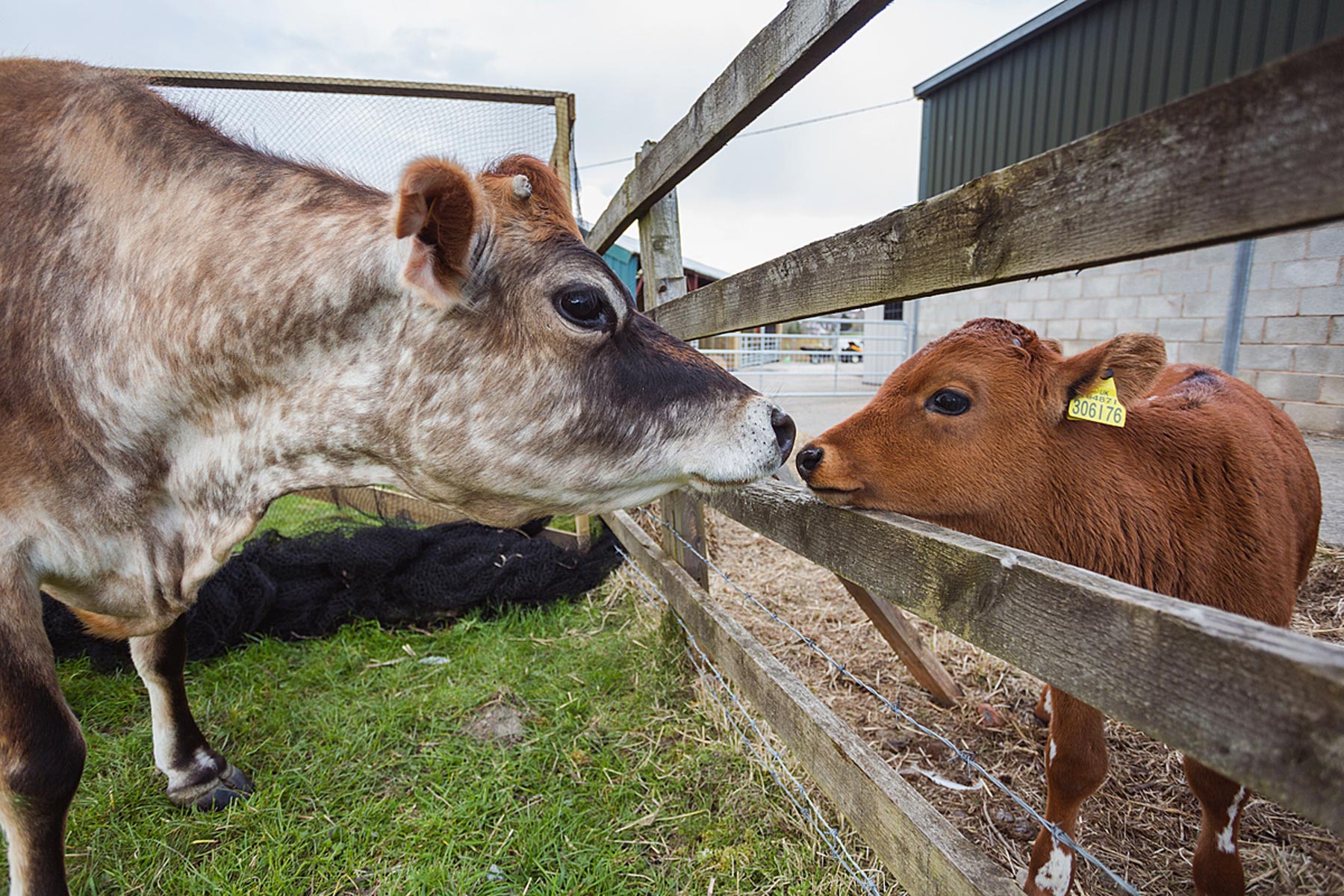
Facts About Animal Agriculture and the Environment
- Agriculture is the leading driver of deforestation, and the farming of cows for beef is the number one cause of deforestation in virtually every Amazon country.
- In North America, 52 percent of all biodiversity loss can be attributed to changes in land use, largely due to farming animals.
- If everyone ate a plant-based diet, we could reduce global land use for agriculture by 75 percent, which would be an amazing boon for natural habitats and wildlife.
- Choosing to eat a vegan diet can reduce an individual’s carbon footprint by up to 73 percent.
- Globally, the animal agriculture industry uses between 20 and 30 percent of all freshwater while in the United States, farmed animals consume one-half of all water used. What a waste!
- The manure from those billions of animals incarcerated inside farms contains nitrous oxide and methane. These get into the atmosphere further driving climate breakdown. And their impact is serious!. Nitrous oxide has a global warming potential 265 times higher than carbon dioxide, while methane’s effect on global warming is 28 times higher.
- Manure from America’s factory farms contains more than 150 pathogens, including ammonia, hydrogen sulfide, methane, and particulate matter. Not only does this create air pollution and unpleasant smells for local residents, but there are serious health consequences for those who live nearby, including increased risks of lung disease, asthma, respiratory problems, and heart attacks.
Is Animal Agriculture Bad for Human Health?
It is, and we’ve touched on some of the issues already: the hazards of environmental pollution from manure, and the thousands of deaths from antibiotic resistance. But, sadly, there is more.
Our health is tied to that of our environment, so when we pollute and destroy it to create grazing for farmed animals, for example, we increase pandemic and other health risks for ourselves. Plus, intensive farms—especially farms rearing chickens, ducks, and pigs—are notorious for their pandemic potential. Such farms are often called “ticking time bombs.” They have already fostered the emergence of several deadly virus strains, and those viruses continue to mutate in stressed, immunocompromised animals trapped inside overcrowded factory farms.
And then we come to actually eating the products. First, all processed meat causes cancer. There is no doubt about that, and all red meat is a probable carcinogen, too.
People who don’t eat meat, eggs, and milk taken from animals have significantly lower odds of suffering from heart disease, type 2 diabetes, and some cancers. Many plant-based eaters also experience digestive, skin, cognitive, and mood benefits. Take a look at some of the amazing stories of people who have transformed their health when they switched to a plant-based diet.

How Can You Change This Scenario?
All of this suffering, all of this damage and destruction, and all of this ill-health is caused by our dietary choices. Of course, we often don’t think of ourselves as ‘choosing’ a diet, more of ‘inheriting it’ from our family and our culture. But that doesn’t mean we can change it, and we can do that with no loss of flavor or enjoyment, and we often get to keep the exact same dishes, since most recipes can be “veganized” quite simply.
The benefits—to us, our friends and family, our communities, our planet, and its wild spaces and wildlife—are so profound, that it is surely worth making these changes if at all possible.
Conclusion
Most of us have some power over our food choices and we can use that power to choose great-tasting food that does good in the world. Small tweaks to our diet can have a big impact, such as putting oat milk in your coffee; trying a bean burrito instead of a beef one; and eating a lasagna made with vegan grounds instead of meat. They may taste the same but these simple swaps can make all the difference in the world.
